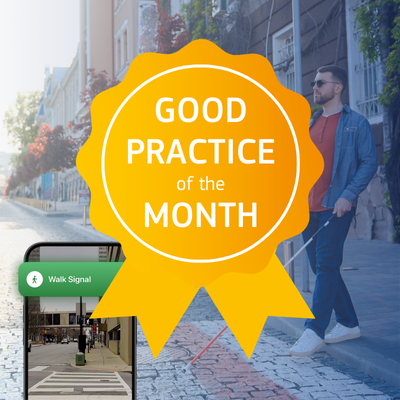This spotlight series is dedicated to showcasing the best practices shared by ERSC members. Each month, we will highlight a different member’s innovative road safety initiative. By highlighting these success stories, we aim to create a collaborative environment where lessons learned and best practices are recognised, celebrated, and adopted by others.
Our August spotlight features the OKO project, by AYES in Belgium, for its impactful work in promoting safe, accessible and sustainable transport for blind and low vision people in Antwerp.
Why the OKO project has been recognised as Good Practice of the Month
European Mobility Week is just around the corner, taking place on 16 – 22 September. This year’s theme “Shared Public Space” advocates for public areas where “people, transport modes and activities all have their own space… with more social equity, more road safety, less noise and air pollution, and a better quality of life”.
With this in mind, it is an ideal moment to highlight innovations that advance sustainable, inclusive, and accessible mobility while boosting road safety. AYES, based in Belgium, is a prime example of such an innovation with its successful OKO app, which has revolutionised urban mobility for blind and low-vision people in Antwerp, Belgium.
Key inspiration behind the OKO project
AYES identified that cities worldwide have faced ongoing difficulties with traditional audible pedestrian signals. These include:
- Costly installation: Up to €50,000 per intersection.
- Noise pollution: Disturbs residents and limits operational hours.
- Maintenance issues: Frequent breakdowns and high maintenance costs.
- Limited functionality: Often not operational 24/7.
AYES set out to address these challenges with a mobile-based solution.
Core activities and outcomes
AYES developed an app which uses smartphone cameras and AI to detect pedestrian signal status and real-time public transport information. It provides audio, haptic, and visual cues to users and operates independently of additional infrastructure or internet connections.
By providing a cost-effective, scalable solution, OKO enhances pedestrian safety and accessibility, making it a vital tool for both urban planners and users. In the past year, OKO has facilitated the safe crossing of 600,000 intersections and continues to support 5,000 crossings daily.
For more information
Click here to read the full Good Practice by AYES, BE, and discover the activities and outcomes of the project in more detail.
If you are interested in implementing a similar initiative in your local authority or Member State, you can contact the AYES Founder, Michiel Janssen, at michiel.janssen@ayes.ai. Michiel can provide further information or advice on the project, as necessary.
Explore all of our members’ Good Practices here. To submit your own Good Practice, please log in to your account and complete the form on this page.
